A man tricked by Gypsies c. 1493
Pen and ink | 26.0 x 20.5 cm (sheet of paper) | RCIN 912495
-
A drawing of a man surrounded by a band of Gypsies in traditional dress, caricatured grotesquely. The man raises his right arm to have his palm read by the old woman on the right – unfortunately the sheet was cut at an early date and the palm-reading trimmed off. While the man is distracted, the grinning Gypsy on the left reaches under his sleeve to steal his purse. The two figures behind stare with hooded brow or laugh hysterically, adding to the sense of claustrophobic menace.
Gypsies had arrived in western Europe around 1420, claiming to be penitent pilgrims from Egypt but soon acquiring a reputation for fortune-telling and theft. Leonardo’s drawing dates from a period of particular hostility to Gypsies in Milan, and they were banished from the Duchy of Lombardy in April 1493, the first such edict in Italy. The drawing was therefore a satire on current affairs, probably made for the entertainment of the Sforza court. It seems to have left Leonardo’s hands and became one of his best-known compositions, serving as the basis for paintings by Giorgione and (possibly) Albrecht Dürer in Venice and Quentin Massys in Antwerp. By the 1580s it was in circulation in Milan and was presumably acquired then by Pompeo Leoni, separately from Melzi’s inheritance. The young Caravaggio was serving his apprenticeship in the city at that time and may have known the drawing, and indeed this was to become a common subject in Caravaggesque painting across Europe in the seventeenth century.
The drawing is the most elaborate of Leonardo’s drawings of figures with exaggerated features, generally known as 'grotesques'. Particularly in the years around 1490, he sketched countless figures in this manner, which can be seen as a counterpart to his concurrent investigations of ideal human proportion (see eg. RCIN 919132, 912601). Leonardo had no intention of introducing such grotesques into his writings or his paintings – they were essentially amusements, for himself and his associates, and probably for the Sforza court too.
On the verso are several lines of notes, the last section of which may be connected with the subject on the recto; translated by J.P. Richter, Literary Works of Leonardo da Vinci, no. 1355:
"This spirit returns to the brain whence it had departed, with a loud voice and with these words, it moved..."And if any man though he may have wisdom or goodness...
"O blessed and happy spirit whence comest thou? Well have I known this man, much against my will. This one is a receptacle of villainy; he is a perfect heap of the utmost ingratitude combined with every vice. But of what use is it to fatigue myself with vain words? Nothing is to be found in them but every form of sin ... And if there should be found among them any that possesses any good, they will not be treated differently to myself by other men; and in fine, I come to the conclusion that it is bad if they are hostile, and worse if they are friendly."
Provenance
Bequeathed to Francesco Melzi; from whose heirs purchased by Pompeo Leoni, c.1582-90; Thomas Howard, 14th Earl of Arundel, by 1630; probably acquired by Charles II; Royal Collection by 1690
-
Creator(s)
Acquirer(s)
-
Medium and techniques
Pen and ink
Measurements
26.0 x 20.5 cm (sheet of paper)
Object type(s)
Other number(s)
RL 12495Alternative title(s)
Five grotesque heads











